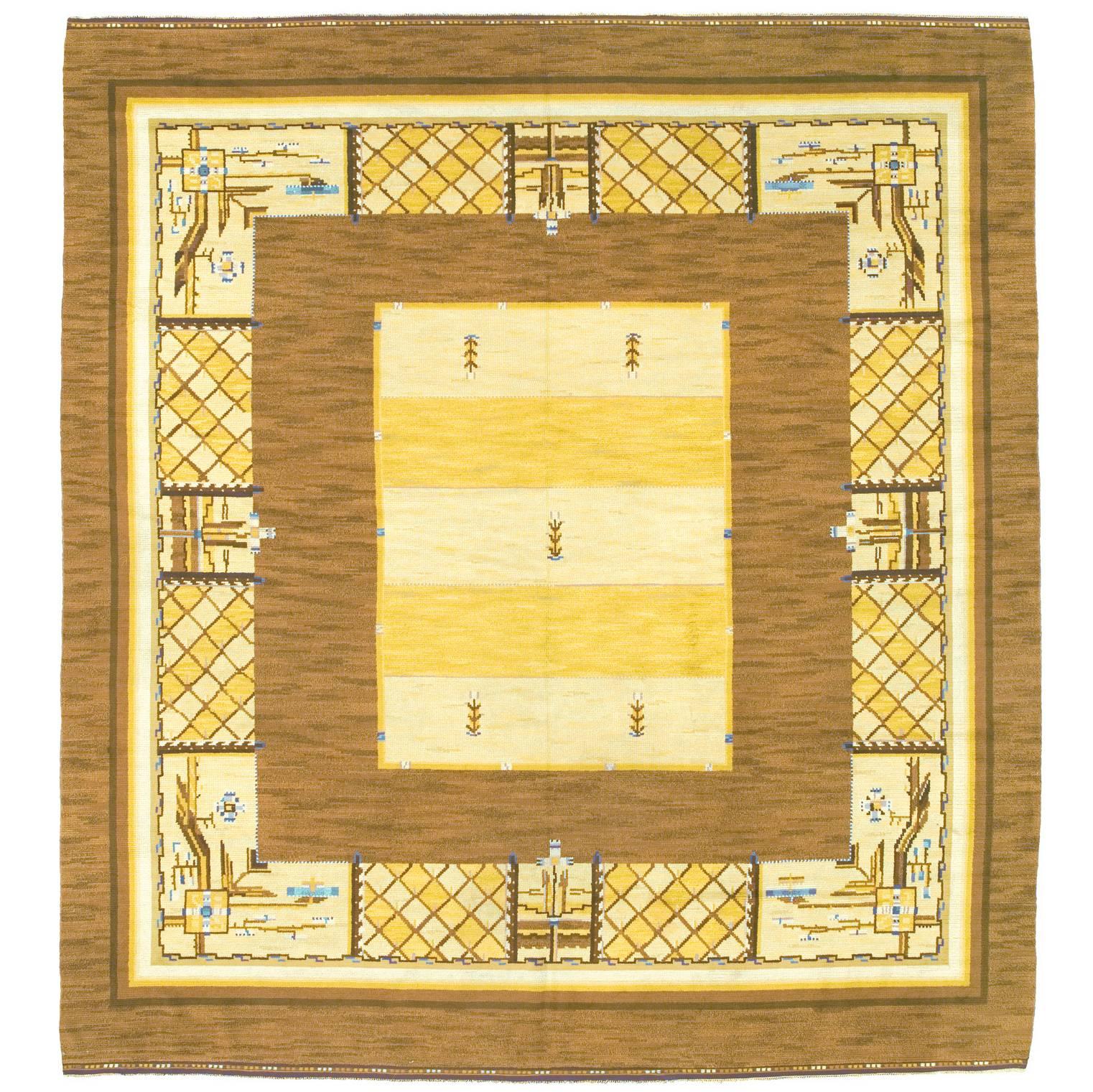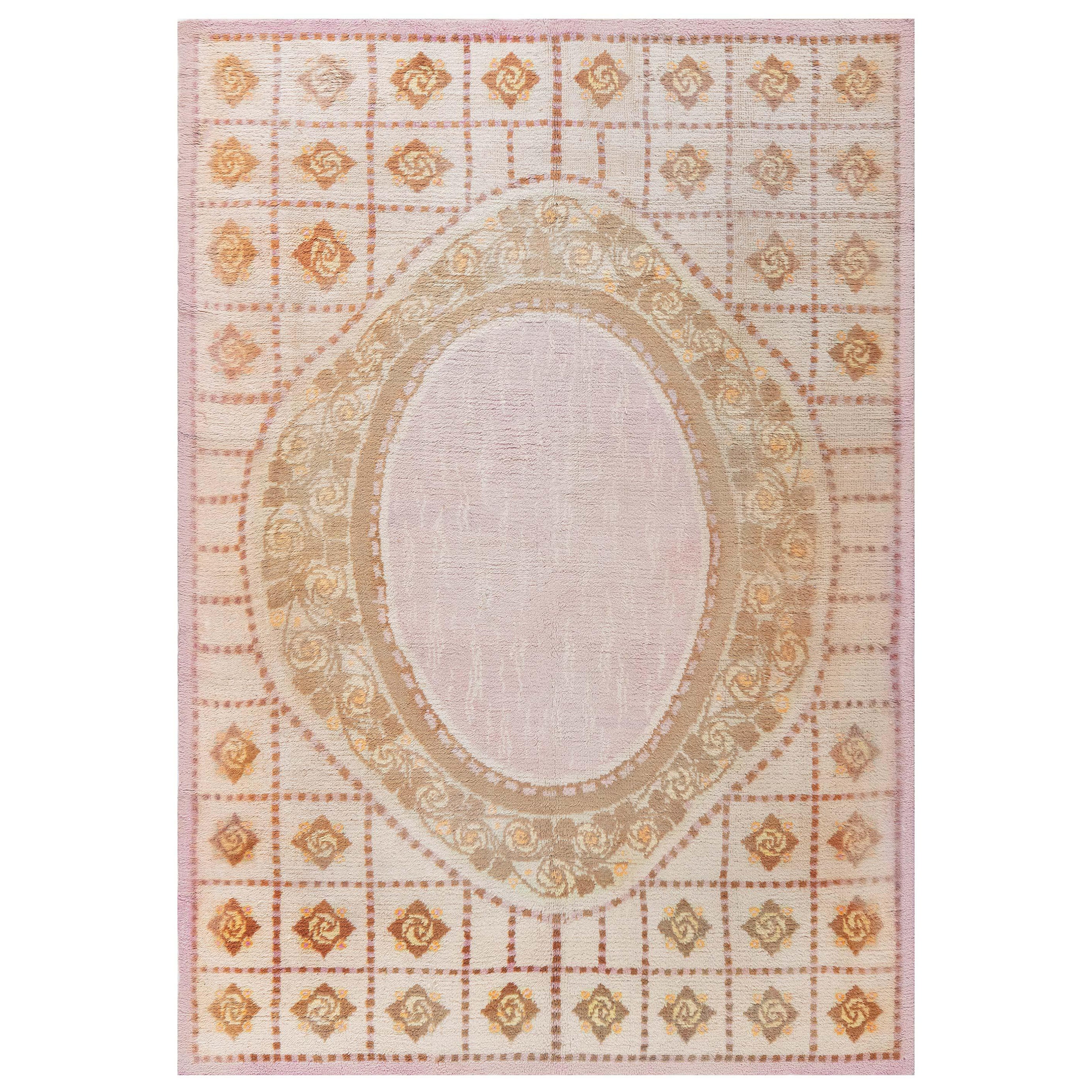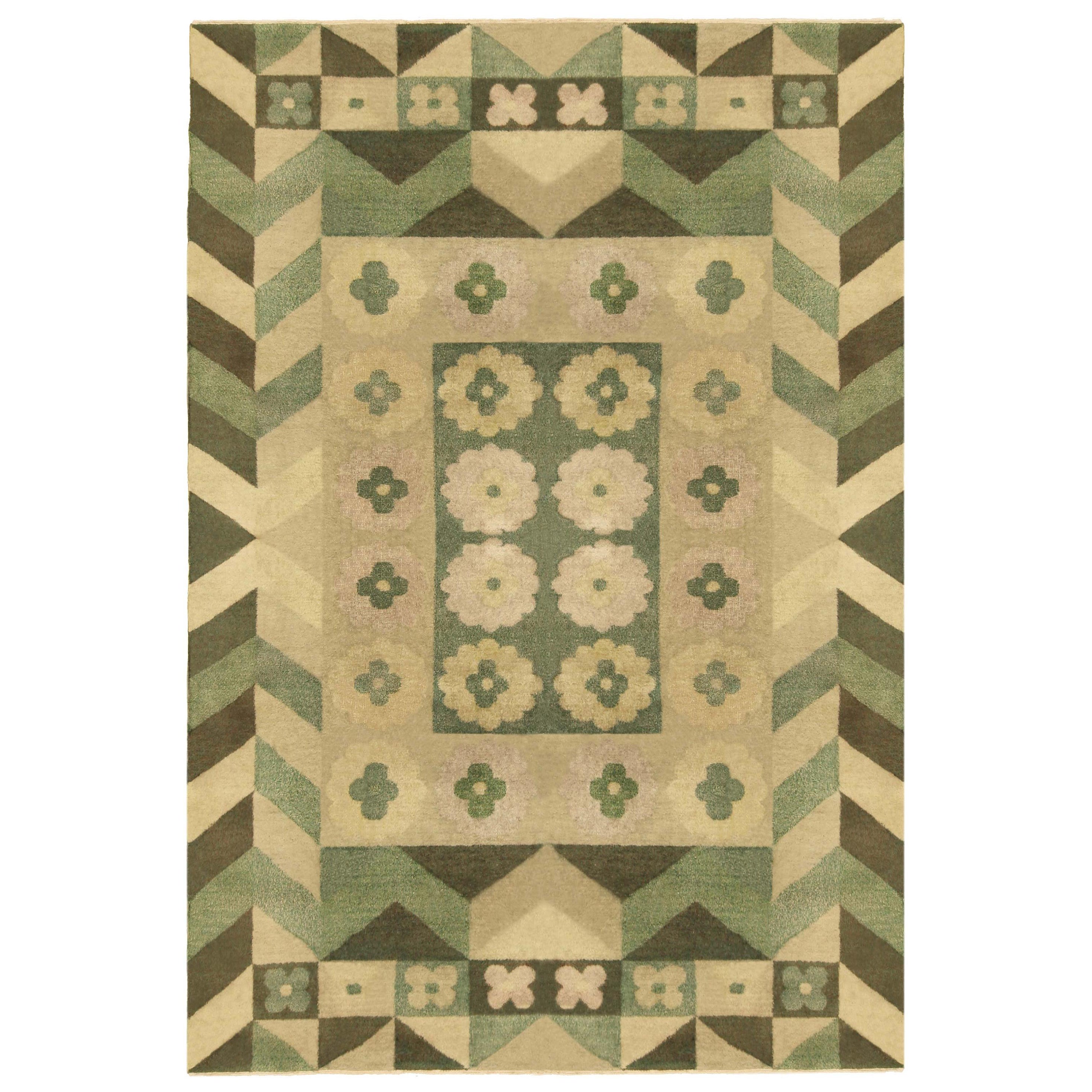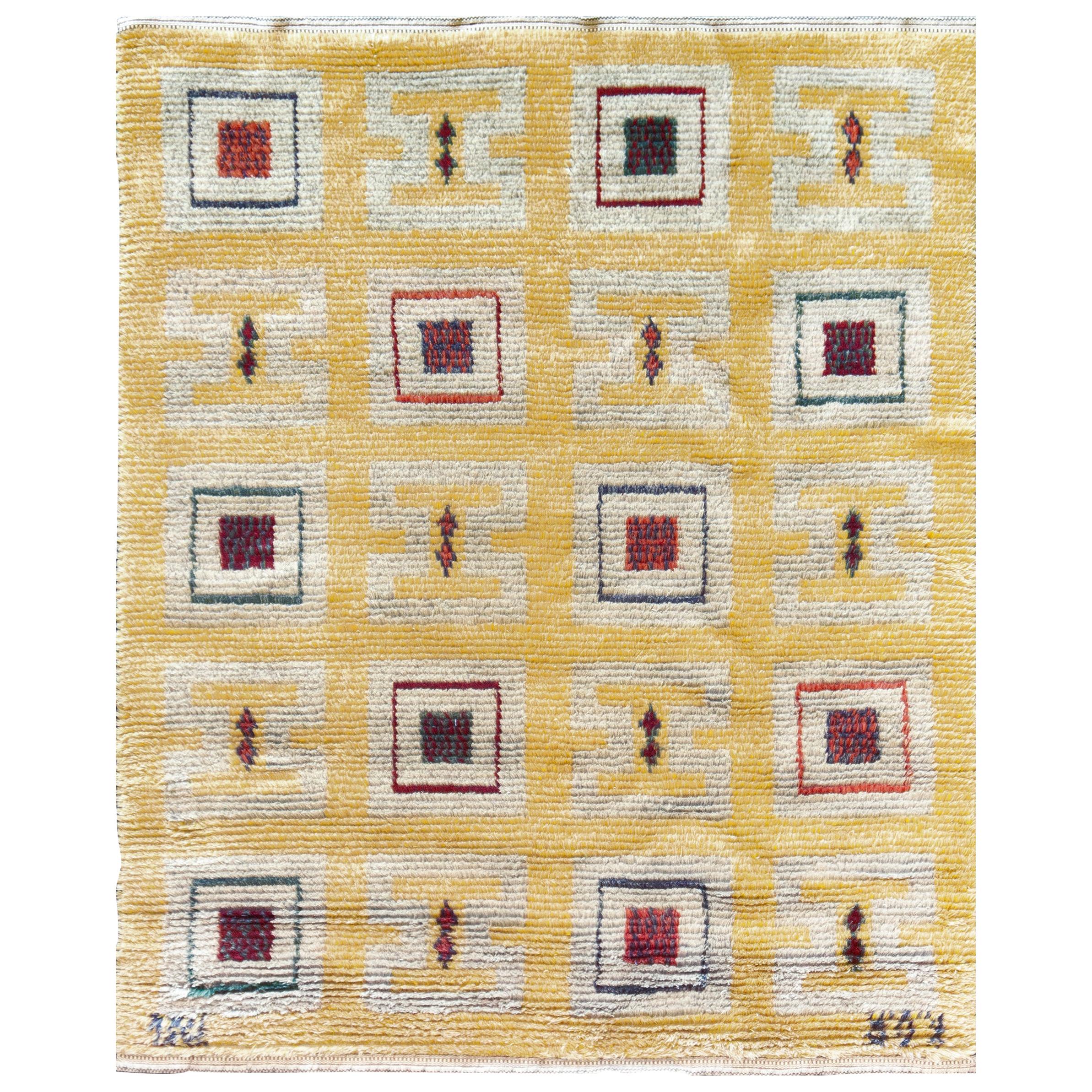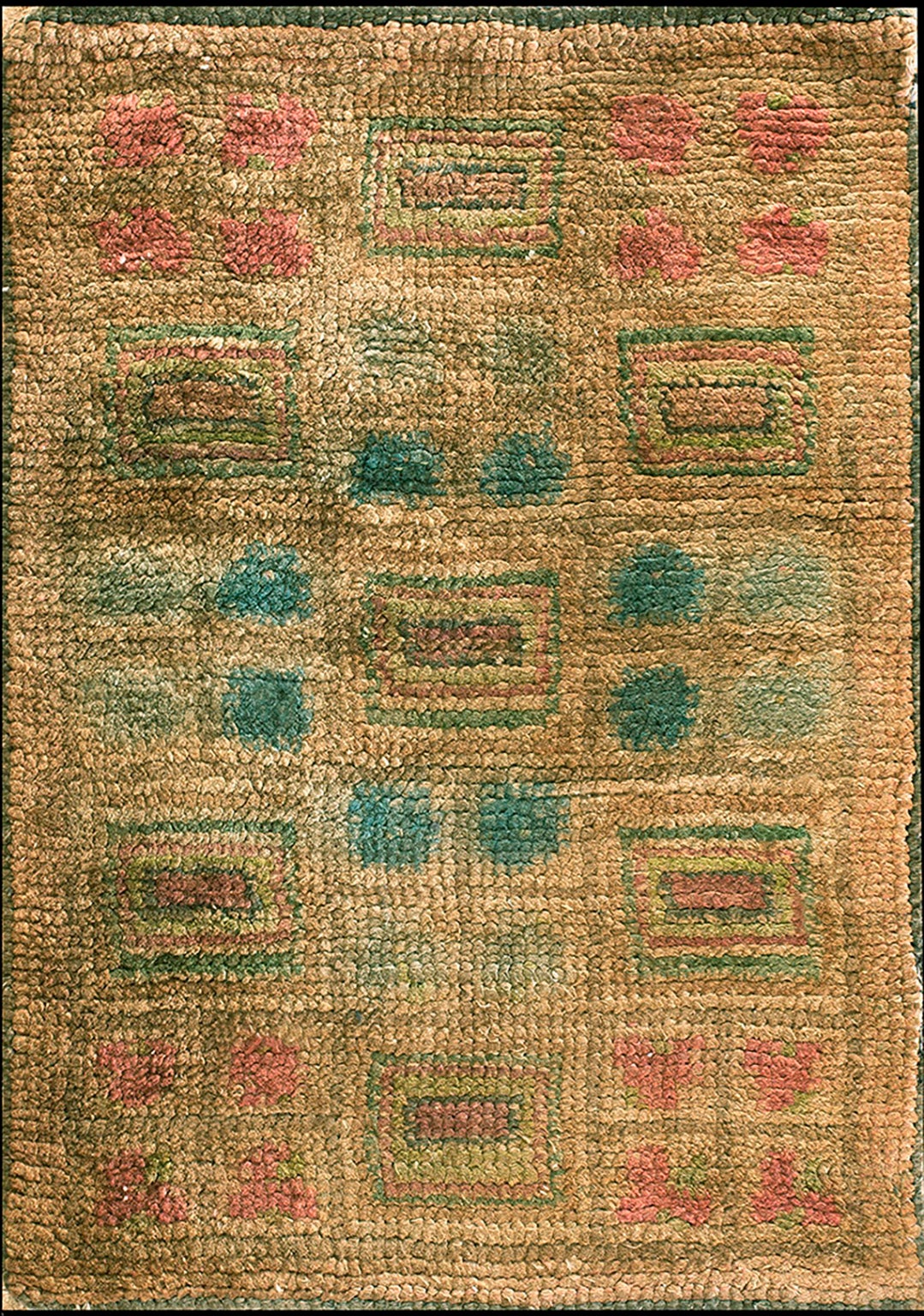Items Similar to Swedish Grace Art Deco Wool Short Pile Carpet by Martha Gahn
Want more images or videos?
Request additional images or videos from the seller
1 of 5
Swedish Grace Art Deco Wool Short Pile Carpet by Martha Gahn
About the Item
Portman Gallery is pleased to offer a 1930s Swedish short knotted pile carpet by Martha Gahn.
An exemplary Swedish Grace, as art deco was called there, pile carpet.
Incredibly supple and soft. In excellent condition for its age.
272 X 182 cm, signed MG.
Browns, greens, a bit of blue and ochre, off-white, eggplant. Deco stepping, abstracted florals.
Condition: some ever so slight organic reshaping with time. Two or three pieces of carpet tape help to keep it entirely flat.
Free same day green delivery to the NYC area.
Märtha Fredrique Gahn
1891-09-30 — 1973-10-17
Textile artist
Märtha Gahn renewed profane and sacred textile art during the first half of the 1900s, and she was one of the first textile artists to cooperate with the textile industry to create patterns for printed fabrics.
Märtha Gahn was born in 1891 and grew up on her family estate Kåfalla in Örebro county, together with her three brothers. Her father, Captain Henrik Jakob Fredrik Gahn, had inherited the manor estate and the iron foundry. He died early, in 1910, and their mother Ellen Gahn, née Silfverstolpe, thus became a widow at the age of 44. Her upbringing on the manor estate was a continual inspiration to Märtha Gahn and it eventually left its mark on a great part of her textile production.
After their father’s death, the family moved to Stockholm and Märtha Gahn began studying to be a textile artist at the Higher industrial arts school at the Technical College, now Konstfack. Immediately after completing her education in 1915, she started the atelier Ateljé Handtryck together with Elsa Flensburg, Märtha Hjortzberg and Bror Geijer-Göthe. They printed patterns using their own stereo plates and silk and cotton fabrics. The patterns were inspired mainly by renaissance and eighteenth-century models.
After two years, Märtha Gahn left Ateljé Handtryck and became the artistic leader of the textile section of the Swedish crafts association Föreningen för Svensk Hemslöjd, that had been founded in 1899 by Lilli Zickerman. Märtha Gahn worked as a pattern designer and also accompanied Lilli Zickerman on her stocktaking trips. One year she also ran the association’s test weaving institution in Vittsjö. The association composed artistic and aesthetically attractive patterns for carpets and furniture upholstery among other things. They were later made into products by women weavers around the country.
Märtha Gahn became an important artistic influence with her own form language. She composed a great number of patterns in the spirit of the association, her creativity showing a contemporary awareness while using traditional techniques. The association’s basic idea was to preserve the traditions from folk crafts and on that foundation to develop new patterns and forms. One of Märtha Gahn’s notable achievements was to vary the classical textile stripes. Stripy fabrics for furnishings and fittings suited the early twentieth century’s new furnishings ideal very well, with its simple, light style, inspired by among others Carl and Karin Larsson. The handwoven furniture fabrics suited the contemporary modern home excellently and the association received several extensive furnishing assignments for which Märtha Gahn was a driving force. Among them was the furnishing of Harpsund Manor in manor house style.
Märtha Gahn also participated in starting the group Verkstaden 1918, a fellowship of several of the most well-known artists, architects and craftsworkers of the time. Their most notable achievement was an exhibition in 1921 that won a good deal of attention.
The Föreningen för Svensk Hemslöjd took part in the Paris International Exhibition of Modern Decorative and Industrial Arts in 1925 with among other things carpets and hanging tapestries composed by Märtha Gahn. For the Stockholm Exhibition in 1930 she received a commission from Borås Wäfveri AB to compose patterns for printed fabrics. This is an early example of the collaboration between a well-known artist and the textile industry with the emphasis on printed fabrics. The six different patterns on her fabrics were both retrospective towards the Gustavian style and also geometric in the modern style. This was the first exhibition in Sweden to show a section with textiles produced only by machines and it was given a good deal of attention. Märtha Gahn also participated with furnishing fabrics, carpets and church textiles for Föreningen för Svensk Hemslöjd and carpets for the carpet factory Kasthalls Mattfabrik in Kinna.
After 15 years as the artistic leader of Föreningen för Svensk Hemslöjd, Märtha Gahn worked for two years as a teacher and artist at another crafts association, Handarbetets Vänner, before she succeeded Agda Österberg in 1935 as the director of Libraria Konsthantverk AB. The atelier Libraria in Stockholm was developed in the 1910s into a company producing church textile art. The enterprise was linked to the board of deaconry of the Swedish church. Märtha Gahn remained at Libraria until her retirement, and during her time there, about 3,000 vestments, antependia and chancel carpets were delivered. She also began to compose and order her own silk patterns and her greatest source of inspiration was the Swedish flora. She strove to develop Libraria into a living centre for modern church art and introduced a new spirit in collaboration with various artists and crafters. Märtha Gahn had already during her time at Föreningen för Svensk Hemslöjd composed church textiles, among other things a new chancel carpet for the Engelbrekt Church in Stockholm in 1924. She considered that it was of great significance for church textiles to be composed so that they related to local tradition in the various country districts and to the character of each respective village or town. An important aspect of Libraria’s activities was also to repair and put in order older damaged and worn church textiles.
Märtha Gahn was also active as a folk educator, writing articles and holding lectures, above all for various women’s associations, about textiles and home decoration. After her retirement, she continued to devote herself to church art, both as an advisor and by composing church textiles in her own company Kristlig Konst in Vaxholm.
Märtha Gahn died in 1973, at 82 years of age.
Anna Lindqvist
(Translated by Alexia Grosjean)
Published 2020-03-02
With thanks to SKBL Sweden for the reprinting of the biographical essay.
Märtha Fredrique Gahn, Svenskt kvinnobiografiskt lexikon (article by Anna Lindqvist), retrieved 2023-06-09.
- Creator:Märtha Gahn (Designer)
- Dimensions:Width: 71.66 in (182 cm)Length: 107.09 in (272 cm)
- Style:Art Deco (Of the Period)
- Materials and Techniques:Wool,Hand-Woven
- Place of Origin:
- Period:
- Date of Manufacture:1933
- Condition:Wear consistent with age and use. Minor structural damages. Fringes removed. Not necessarily a bad thing.
- Seller Location:Brooklyn, NY
- Reference Number:1stDibs: LU7498234330072

About the Seller
5.0
Gold Seller
These expertly vetted sellers are highly rated and consistently exceed customer expectations.
Established in 2022
1stDibs seller since 2022
11 sales on 1stDibs
Typical response time: <1 hour
- ShippingRetrieving quote...Ships From: Brooklyn, NY
- Return PolicyA return for this item may be initiated within 14 days of delivery.
More From This SellerView All
- Swedish Märta Måås-Fjetterström "Bla Heden" Special Order Rölakan CarpetBy Märta Måås-FjetterströmLocated in Brooklyn, NY"Bla Heden" (Blue Heath) was designed by Märta Måås-Fjetterström in 1931. Acquired by the Crown Prince of Sweden and his Consort in the same year, it is one of the firm's most belo...Category
20th Century Swedish Modern Russian and Scandinavian Rugs
MaterialsWool, Linen
- Barbro Nilsson for Märta Måås-Fjetterström "Enbär" Juniper Berry Swedish CarpetBy Barbro Lundberg Nilsson, Märta Måås-FjetterströmLocated in Brooklyn, NYOff of hold after a fresh wash and lash restoration. Please note there is no longer fringe on this rug. Barbro Nilsson for Märta Måås-Fjetterström "Enbar," or Juniper Berry, sma...Category
Mid-20th Century Swedish Scandinavian Modern Russian and Scandinavian Rugs
MaterialsWool, Linen
- Märta Måås-fjetterström “Schackrutig Brun” Brown Grid Carpet Signed Ab Mmf BnBy Märta Måås-Fjetterström AB 1, Barbro Lundberg NilssonLocated in Brooklyn, NYBarbro Nilsson, easily Sweden’s greatest colorist of the Twentieth Century, shows us here that she can do subtlety as well as statement. This example, with a small amount of contrast...Category
20th Century Swedish Scandinavian Modern Russian and Scandinavian Rugs
MaterialsLinen, Wool
- Märta Måås-Fjetterström "Crocus" Handwoven Linen-backed Swedish Wall HangingBy Märta Måås-Fjetterström, Märta Måås-Fjetterström AB 1Located in Brooklyn, NYCrocus tapestry by Marta Maas Fjetterstrom. A nice, and somewhat rare, size, and fully backed with linen and tabs for inserting a dowel rod. This design was made in many colorways, w...Category
Mid-20th Century European Scandinavian Modern Tapestries
MaterialsWool, Linen
- Märta Måås-Fjetterström signed “Bandet” Tapestry by Ann-Mari ForsbergBy Märta Måås-FjetterströmLocated in Brooklyn, NYPortman Gallery is pleased to present a tapestry woven in Bastad at the storied weavery Märta Måås-Fjetterström, designed by Ann Marie Forsberg in the mid-twentieth century. “Bande...Category
Mid-20th Century Swedish Mid-Century Modern Tapestries
MaterialsWool
- Pair of Blue Ligne Roset Facett Swivel Chairs by Ronan and Erwan BouroullecLocated in Brooklyn, NYPortman Gallery is pleased to offer two Facett swivel chairs by R & E Bouroullec for Ligne Roset. This the chair equivalent of Phoebe Philo’s turn of the century work for Chloe. D...Category
Early 2000s Swivel Chairs
MaterialsWool
You May Also Like
- Early 20th Century Swedish Pile-Weave Carpet by Martha GahnBy Märta Gahn 1Located in New York, NYEarly 20th century Swedish Pile-Weave Carpet by Martha Gahn Sweden, ca. 1920 Handwoven Initialed: MG (Märtha Gahn)Category
Vintage 1920s Swedish Scandinavian Modern Russian and Scandinavian Rugs
MaterialsWool
- Vintage French Art Deco Handwoven Wool CarpetLocated in New York, NYVintage French Art Deco handwoven wool carpet Size: 6'8" x 10'0" (203 × 304 cm) A modern early 20th century French deco rug, the greyish field with a square tile cartouche design ove...Category
Early 20th Century French Art Deco Western European Rugs
MaterialsWool
- Art Deco Design Green Handmade Wool CarpetLocated in New York, NYArt Deco Design Green Handmade Wool Carpet Size: 6'10" × 10'2" (208 × 310 cm). This circa 1940 vintage Art Deco antique carpet features an all-over design of floral abstractions and ...Category
Mid-20th Century French Art Deco Western European Rugs
MaterialsWool
- Vintage Art Deco Geometric Handmade Wool CarpetLocated in New York, NYVintage Art Deco geometric brown, beige handmade wool carpet Size: 5'4" × 7'0" (162 × 213 cm) An early 20th century Art Deco tile carpet in light brown and sand with an overall patte...Category
Early 20th Century French Art Deco Western European Rugs
MaterialsWool
- Signed Swedish Deco Pile RugLocated in West Hollywood, CAThis traditional handwoven wool midcentury Swedish deco pile rug has alternating rows of checkered geometric pendants on a butter yellow field. Signed by the weaver/design studio.Category
Vintage 1950s Swedish Mid-Century Modern Western European Rugs
MaterialsWool
- 1930s Swedish Art Deco Carpet ( 2'1" x 3'1" - 64 x 94 )Located in New York, NY1930s Swedish Art Deco Carpet ( 2'1" x 3'1" - 64 x 94 )Category
Vintage 1930s Swedish Art Deco Western European Rugs
MaterialsWool
